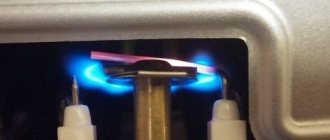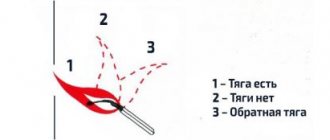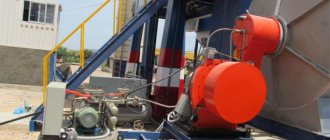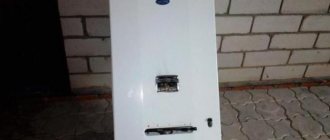External signs of a geyser malfunction
If the junkers gas water heater does not light up, the reasons for this may lie in external factors not related to the condition of the main equipment.
- Incorrect piping. In this case, it is necessary to check the connection of both the inlet and outlet pipes, which will also ensure an uninterrupted water supply.
- No traction. This is usually caused by the chimney being clogged with a large amount of dust or foreign objects. Thus, combustion products are not removed and the burner goes out. In such a situation, you need to bring your hand to the chimney or a small flame (from a match or lighter). An important condition is the presence of an open window. If the draft level is sufficient, the flame will be deflected, and air movement will be felt on the palm.
- There is an unpleasant smell of gas in the room, which may be caused by neighbors installing an antenna above the chimney. In this case, you must immediately turn off the water heater, ventilate the room and call special gas services.
- The column ignites, but after a while it fades out. This may be caused by excessive “sensitivity” of the protective relay. In such a situation, it is necessary to cool the room by opening the windows and contact service to replace the relay.
- A discharged battery or battery may also cause the automatic ignition unit to not operate. This indicates the need to replace them, which you can do yourself.
- Low water pressure may indicate a malfunction of the junkers geyser if the water pressures, for example, in the bathroom and in the kitchen, are different. If they are equally small, then the reason is a weak water supply network.
- Extinguishing the wick can be caused by an oblique, uneven flame. As a result, poor heating of the thermocouple occurs, which automatically turns off the unit. In this case, it is necessary to clean out the dust, which is a mandatory preventive measure when the wick goes out.
Now the time has come to write an article not about computers and 1Ski, but about repairing a Bosch/Junkers WR13 gas water heater. Who would have thought that an IT specialist would climb there. It’s a tradition that such things are best left unchecked in the departments of gas companies and without special knowledge. In fact, there is nothing terrible there, and with more or less straight hands, you can do it yourself. Moreover, there is a crisis in the country and you want to save money. It all started when the heater stopped going off when the hot water was turned off, so I had to run and turn off the gas manually. Googling suggested that two main blocks are responsible for this: hydraulic fittings (water unit) and gas fittings. They are connected together in such a way that when water is supplied, the water unit, using a membrane pressing on the pin, presses on the gas valve, thereby opening the gas supply. When the water is turned off, the gas valve closes. In general, the problem is somewhere here! (number 14 in the picture)
So, let's get started... Here is our patient:
All we need is 2 screwdrivers (Phillips and flathead) and a wrench to unscrew the nut securing the water pipe. For safety, we will cut off the water and gas supply to the apartment. Remove the protective casing by unscrewing the two screws from the bottom:
We gain access to the insides: Remove the bracket securing the water supply pipe to the heat exchanger:
We take out the pipe itself:
Unscrew the two screws securing the water unit to the gas fittings:
And then I saw a picture of oxides at the attachment point. The mechanism was blown apart and water leaked out. The metal oxidized and began to jam the gas valve (it stopped returning to its original position). This is the reason for not turning off the gas supply! Let's try to clean everything up as much as possible and develop the valve itself:
It should press inward and return to its original position. Now let's look at the water block itself:
We take out the bracket and take out the flow regulator (sleeve with a spring):
Unscrew the bolts and remove the water unit cover:
Underneath we see a worn membrane:
And the lid itself has fallen apart over time (the column is currently 7 years old):
As it turned out, spare parts for gas water heaters are not so easy to find. And the prices for them, frankly speaking, are outrageous. With the price of a new Bosch Junkers GWH 13 P (WR13-2 P2) speaker – 10,000 rubles. I found the cheapest membrane in the city (code 8700503083) for 1,400 rubles. and water fitting cover WR10, 11, 13, 15 (code 8705500105) for RUB 2,400. Total 3600 rub. More expensive than a third of the column. So before you start repairing, think about whether it is necessary. But it was already too late... the column was disassembled and I didn’t want to install a new one, so I decided to continue what I started! (although I almost freaked out and didn’t go for a new Chinese one for the same money) The picture shows old and new parts. The difference is immediately visible:
Now we install a new membrane and water valve cover, assembling everything in the reverse order:
Hooray. Everything worked out for me. Now the flame lights up and goes out as it should! What do you want to say in the end?! When I was puzzled by the choice of column 7 years ago, Junkers were praised as the most reliable and repairable. I find it difficult to say whether 7 years is a lot or a little for reliability, although the old Soviet ones still work for people and at least they care! But at such prices for spare parts, this maintainability is not needed. Now I would choose the cheapest Neva or Chinese Oasis for 4-5 thousand rubles and if it breaks, I would simply throw it away without worrying and install a new one for the price of repairing this Junkers/Bosch. One hope is that this prevention will allow the column to work for at least as long... And finally, for those who don’t understand the pictures, I’ll give a link to a video on disassembling Bosch/Junkers gas burners from the company Teplotekhnika St. Petersburg: https://www. youtube.com/watch?v=a2aIn93fyQ8
Internal factors causing attenuation of the gas column
The reasons why the Junkers gas water heater does not work may be the following:
- the batteries have expired;
- the membrane is damaged (for example, it ruptured in one or more places);
- malfunction of control sensors;
- plugged and/or clogged pilot burner;
- worn-out condition of the micro-switch (no clicking sound);
- the water fittings are jammed due to the formation of rust on them;
- dirty condition of the filter element, as a result of which the water flow is limited;
- During installation, the inlet and outlet for water supply may have been confused;
- the electrical circuit is in a damaged state (for example, broken);
- the valve on the gas pipe may be accidentally closed;
- the electrodes are clogged (there is no proper contact), which leads to failure of electric ignition.
Repair of Junkers geysers in Moscow
The workshop offers an on-site range of cleaning services
, prevention and
repair of the Junkers geyser
.
We cover areas of Moscow and the Moscow region. The list of works includes the restoration of defective units and faulty components: wick group, solenoid valve block, safety automatics. Check the heat exchanger for wear and strength. Flushing the burner, increasing the air flow to increase water heating in winter. Repair of Junkers geysers
as part of technical cleaning. Replacement of consumables and lubrication of jammed mechanisms.
We leave behind a guarantee confirming the presence of the master. We indicate the faulty column, type of repair and cost. Repair of geysers Junkers
with travel outside the Moscow Ring Road is paid separately - 30 rubles = 1 km.
- The wick lights up and goes out →
- Cleaning the geyser →
- The column does not light up →
- The water heater does not heat the water →
- The column turns off →
- The speaker goes out →
- The igniter/wick goes out →
- Water drips from the column →
How to determine that there are internal faults in a gas water heater
The reasons why the water heater goes out may be the following:
- filters are clogged;
- the membrane is deformed.
If the quality of water supplied to the room is unsatisfactory (for example, hard, with a large amount of lime impurities), the metal filter grid becomes clogged. To restore the normal functioning of the unit, it is necessary to clean (replace) the mixer filter. Cleaning can be done with ordinary detergents to remove rust and scale. It is also important to clean the column itself from soot formations.
To examine the membrane, the bolts that secure the front panel of the speaker are unscrewed.
When inspecting the membrane, attention is paid to its shape (so that there are no deformations) and the presence of any chips.
If such defects are detected, it must be replaced. And it is better to choose a silicone membrane, since its surface is more durable and elastic.
In this regard, the service life of this part will be longer.
To install the membrane, it is better to use the services of specialists, which will undoubtedly be safer. In addition, when you call a technician, you can simultaneously carry out a general cleaning of the unit and conduct a full diagnostic of the device.
The reasons for the attenuation of the gas column may also be the following:
- unequal pressures of hot and cold water, which can be solved by simply regulating the water supply;
- lack of cold water before starting the unit, which, by the way, leads to rapid damage to the column;
- insufficient time to hold the ignition button (20 seconds is the required duration);
- There is a malfunction of the flue gas sensor, which can be determined by calling.
Conditions conducive to breakdowns of the Junkers geyser
The following factors can cause a gas unit to break down:
- lack of the required amount of oxygen, which is necessary for the proper operation of the equipment;
- simultaneous opening of cold and hot taps;
- lack of necessary regular equipment maintenance to facilitate timely detection and elimination of breakdowns;
- the use of long gas hoses, which cause a decrease in gas pressure.
Malfunctions requiring mandatory contact with a specialist
There are two main reasons why a geyser goes out:
- one of three emergency sensors is triggered: traction, overheating or combustion;
- the column is clogged, which makes it completely impossible to ignite.
Initial actions in cases where the unit stops working:
- To exclude the first option, you need to make sure there is no smell of gas, and draft is carried out in the chimney. If this is detected, you need to call a professional to clean the smoke valve.
- The overheating sensor turns on if the heat exchanger is clogged or the control automation does not work. Its purpose is to protect the copper coil. In this situation, ventilate the room and wait until the unit cools down. Contacting a specialist is mandatory, since only a trained gas technician can properly regulate the column after descaling it.
- If the third sensor is triggered, the gas supply is automatically shut off. In fact, this sensor is a regular thermocouple. If there is a flame, a current is generated and gas is passed through the solenoid valve. When the fire goes out, the valve shuts off the fuel supply for 10 seconds. In this case, you can hear a characteristic sound reminiscent of snapping fingers.
Important! If the gas water heater emits a gas odor when turned off, it is important to turn off all valves, ventilate the room and call gas services.
Gas boiler does not turn on
When the boiler does not work and not a single light is on, does not react in any way to the power button, the owner is overcome by the most terrible suspicions: the unit is hopelessly broken, serious repairs or installation of new equipment will be required.
The boiler self-diagnosis function is powerless here and the device will not display an error code.
A boiler that does not react in any way to attempts to turn on may turn out to be completely operational, unlike the one that generated an error code
Often the reason is simple: the plug is pulled out of the socket, or the machine is turned off. The plug could be pulled out by a child while playing, and the machine could turn off to protect against a network failure. In addition, there may be no power supply in the entire house - during the day you can easily not notice this.
If everything is fine with the power supply, but the boiler is still silent, unplug it and remove the front cover. The control panel in wall-mounted models is usually secured with two bolts, and the main compartment cover is screwed on at the corners - a Phillips screwdriver is enough to remove them.
The problem may be a blown fuse on the control board, and EuroStar may display error E9 . Find it and inspect it, if possible, check with an ammeter. If a fuse needs to be replaced, look for a spare one on the inside of the lid or other parts of the boiler body. As a rule, the Junkers company makes such a reserve for the user.
After checking the markings, replace the fuse and try to start the boiler without directly assembling it. If everything works, you can breathe a sigh of relief, but if there is no response or the new fuse immediately burns out, you need to call a specialist.
Inspect the inside of the device for signs of short circuits, leaks, broken or pulled wires.
The varistor protects the board from power surges in the network, taking the blow. It may become deformed or even explode
A varistor on the board may be blown or damaged - this indicates that there has been a power surge. The repair is not too complicated or expensive, but it requires soldering the board, and we strongly do not recommend doing this yourself. Entrust the work to a specialist, and buy a voltage stabilizer yourself.
It happens that the boiler does not start working even when the house is cold. In this case, the display or indicators may display the standby mode, and on EuroStar models - error CC . This indicates a lack of communication with the room temperature sensor or boiler thermostat. Check the integrity of the wires and connections, tighten the contacts tightly. If everything is intact, turn the knob on the mechanical sensor, and replace the battery on the electronic one.
We recommend: Pressure testing of the heating system - the most complete information
If a boiler with piezo ignition tries to light a burner, gives a spark, but does not ignite - most likely there is no gas supply or the gas valve is faulty.
After several unsuccessful attempts to start, models of the Ceraclass and Eurostar display the EA error “Flame not detected”, the “reset” button and the temperature indicator 60 flash on the Euroline.
There can be many reasons why the boiler does not recognize the flame: from a closed gas tap to incorrect position of the coding plug
In such a situation, you can only try to light the kitchen stove or unscrew the gas hose of the boiler (with the tap closed and the boiler turned off) and try to briefly open the gas. If there is a hissing sound or the stove turns on, the problem is in the boiler, you need to call specialists from the service department with which you have entered into an agreement for the maintenance of gas equipment.
If there is no hissing, then the gas supply to the house is turned off, wait until the gas supply is restored. In any case, the unscrewed gas hose must be connected back to the boiler without losing the gasket.










